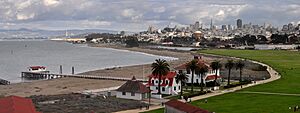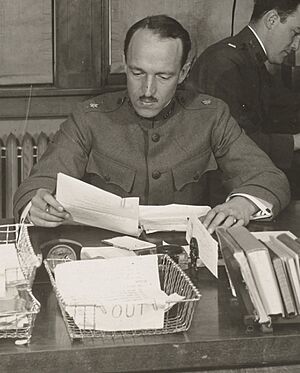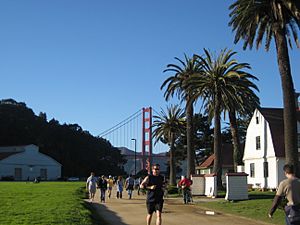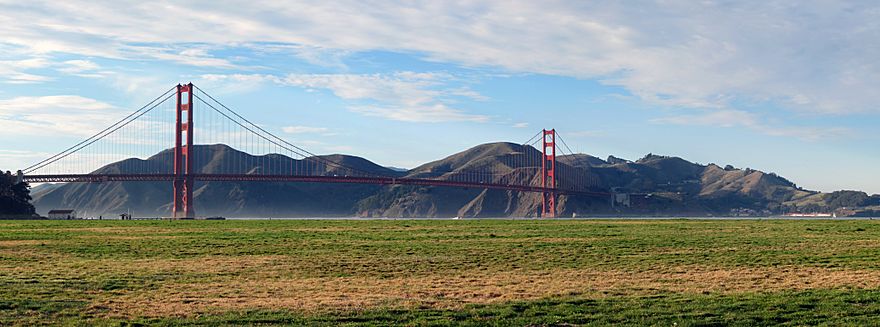Crissy Field facts for kids
Crissy Field is a special place in San Francisco, California, United States. It used to be a U.S. Army airfield, a place where planes would take off and land. Today, it's a beautiful part of the Golden Gate National Recreation Area.
Crissy Field was once part of the Presidio of San Francisco. After 1974, it stopped being an airfield. For many years, the Army used the area, and some harmful waste was left behind. In 1994, the National Park Service took over. They worked with the Golden Gate National Parks Conservancy to clean up and restore the area. By 2001, Crissy Field was open to the public with a new center. Many old buildings from the 1920s are still there. Some are now offices, shops, or homes.
Contents
The Story of Crissy Field
The land where Crissy Field is located was once a large, wet, marshy area. It covered about 130 acres. Long ago, the Ohlone people lived here. They gathered shellfish and fish. They also set up seasonal camps, leaving behind piles of shells.
In 1776, the Spanish arrived and called the area El Presidio. They used the land for farming and raising animals. By the 1870s, the 127-acre marsh was filled in. This was done just in time for the 1915 Panama Pacific International Exposition. The U.S. Army took control of the Presidio in 1846. They used the wet marshland as a place to dump waste. After filling it in, the Army built an airfield on top.
When Crissy Field Was an Airfield
During World War I, the Army built many temporary buildings at the Presidio. They also connected it to Fort Mason with a railroad track. In 1918, Congress decided to build eight "air coast defense stations." One of these was planned for the Presidio to protect San Francisco Bay.
In 1919, Colonel Henry H. Arnold of the Air Service helped choose the best spot. They picked the old exposition site. It had a calm beach for seaplanes. Also, the middle of its racetrack was already being used for planes. After the war, some buildings were taken down to make it safer for planes to land.
The landing field was shaped like a kidney. You could still see the outline of the racetrack. On the western side, there were hangars, workshops, and a garage. Nearby, there was a guardhouse, an office building, and a two-story building for soldiers. Officers lived in houses on the bluff overlooking the field.
Colonel Arnold helped name the field "Crissy Field." It was named after Major Dana H. Crissy. He was a base commander who died in a plane crash in 1919. This happened during a big cross-country flight test. Construction continued through 1920. A ramp for seaplanes was also built. The Army officially accepted the field on June 24, 1921. The first unit, the 91st Observation Squadron, arrived in August.
In its early years, Crissy Field was used for many things. These included watching artillery fire and taking aerial photography. It also helped with flights for headquarters staff. Special missions, like publicity flights and search and rescues, also took place. It was also a support field for U.S. Air Mail. The first forest fire patrols by air in the West started from Crissy Field.
In June 1924, the first successful flight across the United States, from dawn to dusk, ended at Crissy Field. That same year, the Army's first flight around the world stopped here. Lowell H. Smith, who was based at Crissy Field, led the flyers when they returned.
In 1925, two Navy flying boats took off from Crissy Field. They were trying to fly from the U.S. to Hawaii for the first time. The flight was supposed to take 26 hours. But it took twelve days when their plane ran out of fuel. The crew and plane had to be rescued at sea. Two years later, Lieutenants Lester Maitland and Albert Hegenberger flew non-stop to Hawaii. They used a special plane called the Bird of Paradise after preparing at Crissy Field.
At first, Crissy Field seemed perfect for planes. But strong winds and fog often made flying hard. The building of the Golden Gate Bridge also made local flights more difficult. Plus, the 3,000-foot runway was too short for bigger planes. The Army also worried that Crissy Field was too close to the water. This made it an easy target for enemy ships.
In 1936, Hamilton Field opened in Marin County. Crissy Field was no longer a main air base. However, planes continued to use it until the 1970s.
After the Airfield Closed
When the main air operations moved, the administration building became the headquarters for the 30th Infantry Regiment. The landing field was used as a gathering area for soldiers. During World War II, temporary wooden buildings were built. These were used as barracks and classrooms for the Army's Military Intelligence Service Language School. Japanese-American soldiers were trained here to be battlefield interpreters.
After World War II, a paved runway replaced the grass field. The Sixth Army Flight Detachment used Crissy Field for small planes and helicopters. During the Vietnam War, the Army used Crissy Field for quick flights. They also used it for MedEvac flights. These flights transported wounded soldiers from Travis Air Force Base to the Presidio's Letterman Army Hospital. This trip was much faster than by ambulance through city traffic.
At the end of the Vietnam War in 1974, the Army closed Crissy Field to airplanes. Helicopter operations continued for a few more years. In 1994, the Army closed the Presidio as part of a national plan. Crissy Field was left as "a messy mix of asphalt and forgotten buildings." It was then given to the National Park Service.
Crissy Field Today
In 1994, the National Park Service (NPS) took over the Presidio. They called Crissy Field a "run-down concrete wasteland." Because of worries about past pollution, the NPS and the Environmental Protection Agency checked the area for chemicals. The NPS then worked with the Golden Gate National Parks Conservancy to bring the area back to life. The Crissy Field Center opened to the public in 2001.
How Crissy Field Was Restored
A San Francisco company called Hargreaves Associates led the restoration of Crissy Field. George Hargreaves and Mary Margaret Jones were the main landscape architects. They believed in an "ecological approach," which means bringing back natural systems. They also wanted to create a "sustainable landscape." During the planning, Hargreaves and Associates met with the public. They listened to ideas from the local community.
The biggest donation for the restoration came from the Evelyn and Walter Haas Jr. and Harold and Mimi Haas Foundations. They gave $18 million. This was the largest cash gift in National Park Service history at that time. The rest of the money came from the public. About 2,400 people donated to the $34.4 million raised. Most of these donations were $100 or less. Since it reopened in 2001, the Haas Fund has given more money.
Experts handled special jobs like design, building, and removing harmful materials. They also tested the marsh. But parts of the project were done by the community. About 3,000 volunteers, from neighbors to elementary students, spent 2,400 hours planting. They planted 100,000 plants of 73 different native species.
Crissy Field had a challenge: how to restore a military airfield that was also a natural marsh. The goal was to make the marsh look like it did before the military used it as a dump. To do this, 87,000 tons of harmful materials were removed. The tidal wetlands were redesigned to be like the original wetlands. The site now offers amazing views of the San Francisco Bay, Alcatraz, and the Golden Gate Bridge.
Crissy Field officially reopened in 2001. New and rebuilt paths, boardwalks, and trails connect the field. You can walk north to Fort Point and the Warming Hut cafe. South, you can reach the Crissy Field Center, which teaches about the environment. You can also get to the Marina District. Many old buildings were fixed up and are now homes, offices, shops, and fun places. The old temporary wooden barracks were torn down. The grass airfield was restored. Letterman Army Hospital, a large concrete building, was ground into dust. The concrete was recycled. In its place, George Lucas moved his company, Industrial Light & Magic.
What You Can See and Do at Crissy Field Today
Crissy Field is now part of a city national park. It's very popular with both locals and visitors. This is because of its great location and beautiful views.
Fun Features at Crissy Field
- West Bluff — This is the westernmost part of Crissy Field. It has a picnic area and the Warming Hut cafe. You can also find paths and trails that connect to the Golden Gate Bridge and Fort Point.
- Beach and Dunes — The shoreline along Crissy Field has been restored. New sand dunes were created. These dunes provide a home for many native plant and animal species.
- Promenade and Trails — The Golden Gate Promenade runs next to the beach, from the Crissy Field Center to the Warming Hut. This is also part of the San Francisco Bay Trail. This trail goes along the coast of the San Francisco Bay.
- Restored Tidal Wetlands — The restored marsh is now home to 17 types of fish. Over 135 kinds of birds have been seen there. Native plants have been planted around the marsh. A boardwalk crosses the marsh, giving great views of the wildlife.
- Crissy Field Center — This is an environmental education center for young people. It offers programs during the school year and in the summer.
- Cross Country Course — This is where the University of San Francisco's men's and women's cross country teams practice and compete.
Art at Crissy Field
In May 2013, the SFMOMA worked with the National Park Service. They displayed eight sculptures by Mark di Suvero at Crissy Field.







